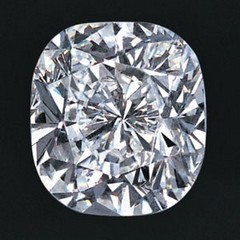The cushion cut diamond is a popular diamond shape known for its rounded edges and square or rectangular outline, giving it a distinctive pillow-like appearance. This cut is a blend of the classic round shape and the square shape, offering a balance of both styles. It has been a beloved cut for centuries and has seen a resurgence in recent years, particularly in engagement rings.
Key Features of the Cushion Cut Diamond:
Shape:
The cushion cut diamond is typically square or rectangular, with rounded corners that resemble a pillow (hence the name). It can come in various ratios, where the length-to-width ratio determines whether the diamond appears more square or more rectangular.
The rounded corners give the cushion cut its soft and vintage look, making it a timeless and romantic choice.
Facets:
The cushion cut has a unique facet structure compared to other cuts. It often has 58 facets (the same as the traditional round brilliant cut), though some variations, such as the modified cushion cut, may have additional facets to enhance brilliance.
The facets on a cushion cut diamond create a larger, more noticeable sparkle, with the light bouncing around the stone in a way that gives it a vintage yet brilliant shine.
Types of Cushion Cut:
Standard Cushion Cut: The traditional cushion cut, with rounded corners and soft edges.
Modified Cushion Cut: A variation that uses additional facets to enhance brilliance. It can be cut with a modern look, featuring sharper corners and a more contemporary style.
Cushion Brilliant Cut: A cushion cut with a modern, brilliant-style facet arrangement, designed for maximum sparkle.
Appearance:
Cushion cut diamonds are known for their soft, romantic glow and are often preferred for their vintage and classic look. This cut is ideal for those who like the glitter of the round brilliant but want something that feels more unique and timeless.
Depending on the specific facet arrangement and cutting style, the cushion cut can have a brilliant appearance, creating a large amount of sparkle and fire, or a antique-style appearance with a more subdued, charming glow.
Popularity:
The cushion cut is especially popular in engagement rings, particularly for those who want a vintage or antique-inspired design. It has also been a favorite among celebrities and is seen in many high-profile engagements.
The cut’s resurgence in popularity is partly due to its combination of classic beauty and modern brilliance.
Durability:
The cushion cut diamond is generally quite durable because of its rounded corners. These corners are less prone to chipping compared to the sharp edges of other cuts, such as the emerald or asscher cuts.
The diamond’s pavilion depth (how deep it is from the table to the culet) can affect its overall durability and brilliance, so a well-proportioned cushion cut will ensure the diamond lasts over time.
Choosing the Right Cushion Cut:
Length-to-Width Ratio: The length-to-width ratio is a key consideration when selecting a cushion cut diamond. A ratio of 1.00 will result in a perfectly square cushion, while ratios above or below 1.00 will create a rectangular cushion shape. The ratio will influence the diamond’s overall appearance and is a matter of personal preference.
Cut Quality: The quality of the cut will have a significant effect on the diamond’s brilliance. Cushion cuts can be brilliant (emphasizing sparkle) or antique-style (more muted and charming). Look for diamonds with excellent or very good cut grades to ensure optimal light reflection and sparkle.
Clarity and Color: While cushion cut diamonds can hide inclusions and color better than other cuts due to their larger facets and the faceted structure, it is still important to check for clarity and color before purchasing.
Ideal Settings for Cushion Cut Diamonds:
Halo Setting: A cushion cut diamond in a halo setting (surrounded by smaller diamonds) is particularly popular, as it amplifies the appearance of the main diamond and adds extra sparkle.
Vintage and Classic Settings: The cushion cut diamond fits perfectly into vintage-style or antique-inspired rings, often with intricate detailing or milgrain edges around the band.
Solitaire Settings: Many people opt for a solitaire setting (a single diamond on the band) for a cushion cut diamond, allowing the diamond to be the main focus.
Brilliance and Sparkle:
The cushion cut is known for its good sparkle due to the faceting structure, but it may not exhibit the same level of fire (colored light reflections) as round brilliant cuts.
The brilliance of the cushion cut comes from the way light interacts with the larger facets. A well-cut cushion can shine brightly and produce beautiful flashes of light.
Cushion Cut vs. Other Cuts:
Round Brilliant vs. Cushion Cut: While round brilliant diamonds are typically the most brilliant (sparkling) due to their specific facet pattern, cushion cuts can offer similar sparkle with a softer, more vintage look.
Princess Cut vs. Cushion Cut: Princess cuts are square-shaped with sharp edges, providing a modern and angular look, while cushion cuts offer a softer, more rounded feel. The choice depends on personal style preferences.
